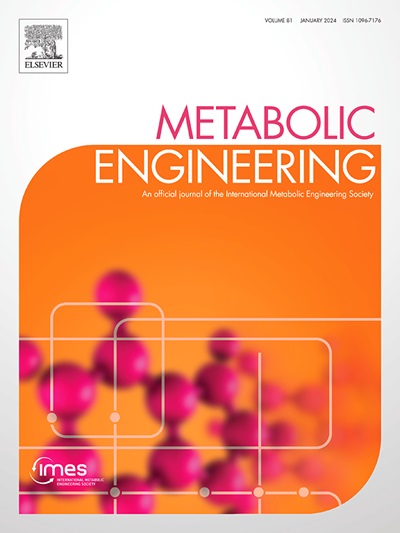Exploring the versatility of fatty acid biosynthesis in Escherichia coli: Production of random methyl branched fatty acids
IF 6.8
1区 生物学
Q1 BIOTECHNOLOGY & APPLIED MICROBIOLOGY
引用次数: 0
Abstract
Microbial fatty acids (FAs) hold significant potential as alternatives for the oleochemical industry. However, expanding the functional and structural diversity of microbial FA-derived products is essential to fully leverage this potential. Methyl-branched-chain FAs (MBFAs) are of particular interest as high-performance industrial compounds. This study examines the ability of the Escherichia coli FA biosynthesis pathway to produce a diverse mixture of random MBFAs (R-MBFAs) by utilizing both the natural malonyl-ACP substrate and the branched-chain methylmalonyl-ACP (mm-ACP) as an unnatural elongation unit. First, E. coli was engineered to accumulate methylmalonyl-CoA (mm-CoA) through a methylmalonate or a propionate-dependent pathway, and the capacity of E. coli FASII enzymes to synthesize mm-ACP and utilize it as a substrate was confirmed by the production of R-MBFAs. However, low R-MBFA accumulation and propionate-induced growth inhibition was observed. To improve R-MBFA yields, various malonyl-/mm-CoA acyltransferase (AT) enzymes were expressed, and their efficacy in generating mm-ACP was indirectly assessed through R-MBFA production levels. When expressing selected ATs, including native malonyl CoA-acyl carrier protein transacylase FabD, propionate-induced growth inhibition was alleviated and R-MBFA titers ranged from 5.9% to 7.7% of total FAs. Further strain optimization, analyzing two thioesterase (TE) activities and overexpression of the E. coli transciptional regulator EcFadR, significantly boosted R-MBFA titers. While an engineered strain carrying the Mus musculus TE domain (MmTE) produced 55.2 mg/L of R-MBFAs, representing an 11.8% of total FAs, another strain combining the overexpression of the cytosolic version of the TE TesA from E. coli (Ec‘TesA) and EcFadR produced approximately 1.1 g/L of total FAs, with an R-MBFA fraction of 6.7% (70.5 mg/L), marking the highest yield recorded in shake-flask cultures. Finally, these two recombinant E. coli strains were grown in laboratory-scale fed-batch fermentations, and produced approximately 10 g/L of total FAs and over 1–1.2 g/L of R-MBFAs, underscoring the potential for large-scale production of these valuable FA-derived compounds.

探索大肠杆菌中脂肪酸生物合成的多功能性:随机甲基支链脂肪酸的生产。
微生物脂肪酸(FAs)作为油脂化学工业的替代品具有巨大的潜力。然而,扩大微生物fa衍生产品的功能和结构多样性对于充分利用这一潜力至关重要。甲基支链脂肪酸(MBFAs)是一种高性能的工业化合物。本研究考察了大肠杆菌FA生物合成途径通过利用天然丙二醇- acp底物和支链甲基丙二醇- acp (mm-ACP)作为非自然延伸单元产生多种随机MBFAs (r - mbfa)混合物的能力。首先,设计大肠杆菌通过甲基丙二酸或丙酸依赖途径积累甲基丙二酸辅酶a (mm-CoA),大肠杆菌FASII酶合成mm-ACP并将其作为底物的能力通过产生r - mbfa得到证实。然而,观察到低R-MBFA积累和丙酸诱导的生长抑制。为了提高R-MBFA的产量,我们表达了各种丙二酰-/mm-CoA酰基转移酶(AT),并通过R-MBFA的产量水平间接评估了它们对mm-ACP的产生效果。当表达选定的ATs(包括天然丙二酰辅酶a -酰基载体蛋白转酰基酶FabD)时,丙酸诱导的生长抑制得到缓解,R-MBFA滴度为总FAs的5.9%至7.7%。进一步的菌株优化,分析了两种硫酯酶(TE)活性和大肠杆菌转录调节因子EcFadR的过表达,显著提高了R-MBFA滴度。携带小家鼠TE结构域(MmTE)的工程菌株产生了55.2 mg/L的R-MBFA,占总FAs的11.8%,另一种菌株结合了大肠杆菌TE - TesA的细胞质版本(Ec'TesA)和EcFadR产生了约1.1 g/L的总FAs, R-MBFA含量为6.7% (70.5 mg/L),这是摇瓶培养中记录的最高产量。最后,这两种重组大肠杆菌菌株在实验室规模的补料分批发酵中生长,产生了大约10 g/L的总FAs和超过1-1.2 g/L的r - mbfa,强调了大规模生产这些有价值的fa衍生化合物的潜力。
本文章由计算机程序翻译,如有差异,请以英文原文为准。
求助全文
约1分钟内获得全文
求助全文
来源期刊

Metabolic engineering
工程技术-生物工程与应用微生物
CiteScore
15.60
自引率
6.00%
发文量
140
审稿时长
44 days
期刊介绍:
Metabolic Engineering (MBE) is a journal that focuses on publishing original research papers on the directed modulation of metabolic pathways for metabolite overproduction or the enhancement of cellular properties. It welcomes papers that describe the engineering of native pathways and the synthesis of heterologous pathways to convert microorganisms into microbial cell factories. The journal covers experimental, computational, and modeling approaches for understanding metabolic pathways and manipulating them through genetic, media, or environmental means. Effective exploration of metabolic pathways necessitates the use of molecular biology and biochemistry methods, as well as engineering techniques for modeling and data analysis. MBE serves as a platform for interdisciplinary research in fields such as biochemistry, molecular biology, applied microbiology, cellular physiology, cellular nutrition in health and disease, and biochemical engineering. The journal publishes various types of papers, including original research papers and review papers. It is indexed and abstracted in databases such as Scopus, Embase, EMBiology, Current Contents - Life Sciences and Clinical Medicine, Science Citation Index, PubMed/Medline, CAS and Biotechnology Citation Index.
 求助内容:
求助内容: 应助结果提醒方式:
应助结果提醒方式:


